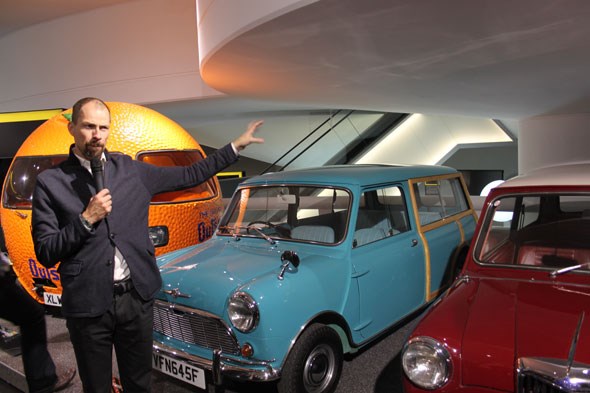
Over the next year and a bit, BMW’s Munich museum is subject to a mini takeover. A giant Mini takeover, in fact. Quite simply, it’s the most complete collection of significant Mini models ever to be in the same place at the same time, telling the brand’s story from start to finish. The exhibition’s called, logically enough, The Mini Story.
We’ve been to an all-night lock-in at the museum with Mini’s chief designer Anders Warming, show curator Andreas Braun and Mini’s senior vice president Jochen Goller, who gave us a grand tour before the doors opened to the public.
‘Mini can be so much,’ said Anders Warming (above), the Dane in charge of Mini’s design team since 2011. ‘Its design can take all kinds of directions; it depends on the love that you put into it.’
Here’s a whistle-stop tour of the exhibition, with Warming’s take on Mini’s past, present and its future.
The Mini originals
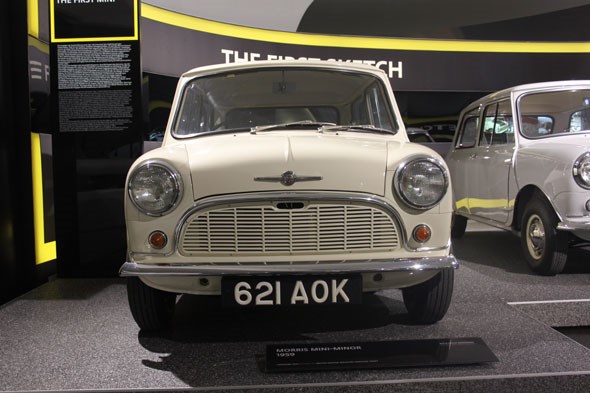
This is genesis, then: 621 AOK, the first Morris Mini-Minor off the line…
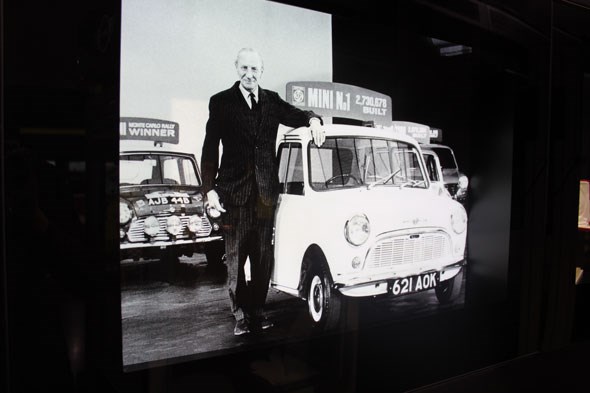
…and the same car pictured next to designer Sir Alec Issigonis in this famous snap (taken at his retirement party in 1971).
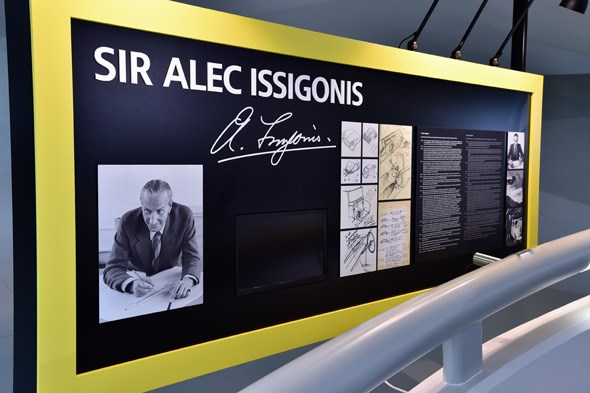
‘As a designer I have to say Issigonis’s drawings were wonderful’, says Warming. ‘He was at heart an engineer [rather than a designer], but one with a highly developed sense of aesthetics. Engineering has to go hand in hand with aesthetics for a design to be successful.’
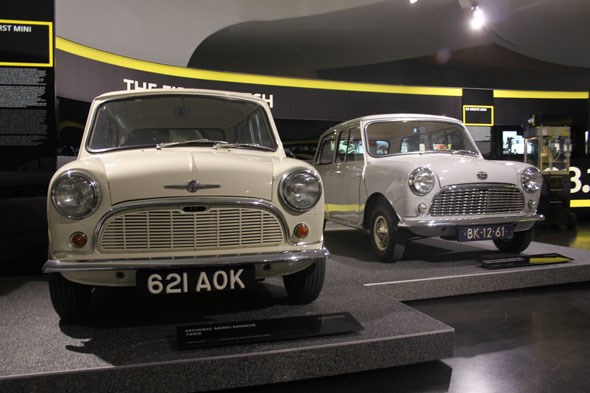
The Mini was first marketed under two separate model lines – the Morris Mini-Minor (left) and the Austin Seven. ‘Lovely colours,’ says Warming. ‘Eggshell White and Bright Grey.’

Know your Minis: there were two different looks for the ’59 Mini. The Austin had chrome inserts on the grille, the Morris didn’t. More on that later…
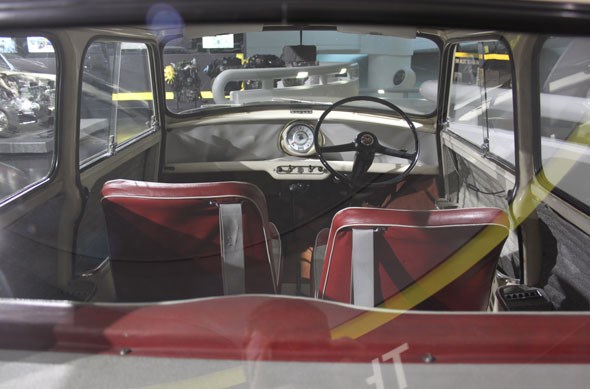
’59 Mini cabin seems impossibly plain today. The round central dial and toggle switches below remain the starting point when designing current Mini dashboards. ‘I have a classic Mini myself,’ Warming says. ‘I drive it quite often to work and I’m still amazed at the amount of interior space.’ Speaking of which…
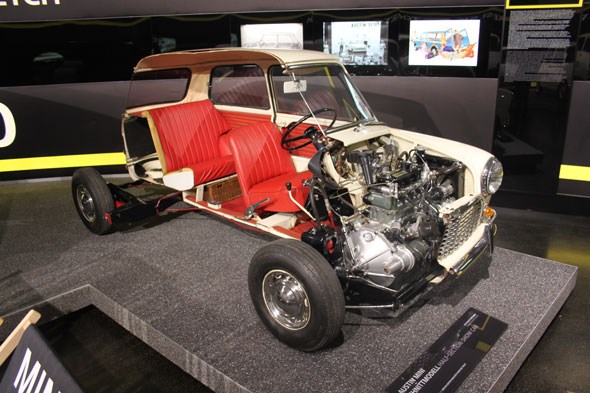
This is the famous half-section show car from the mid-1960s, designed to show off just what a miracle of interior packaging the original Mini was. The transverse powertrain layout means there’s no transmission tunnel to clutter the cabin, although in Warming’s words that means it’s ‘always interesting to find the right gears. I think we can say the modern cars are better in this regard.’
The oddballs
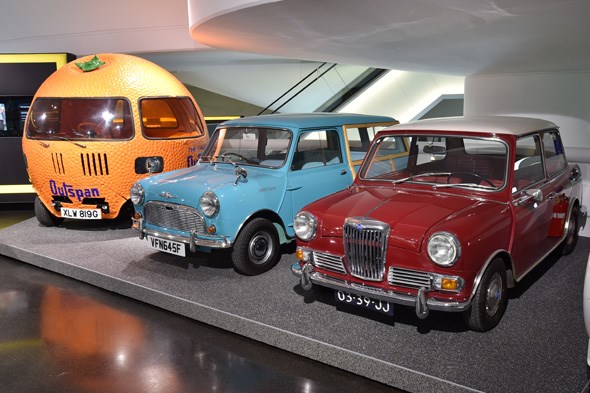
On the right is the Riley Elf, a posh Mini with a boot. ‘It may not be as loved as some of the “real” Minis,’ says Anders, ‘but a wonderful, characterful car. A really interesting three-box design’. In the middle, of course, is the timber-clad Mini Traveller, but on the left?
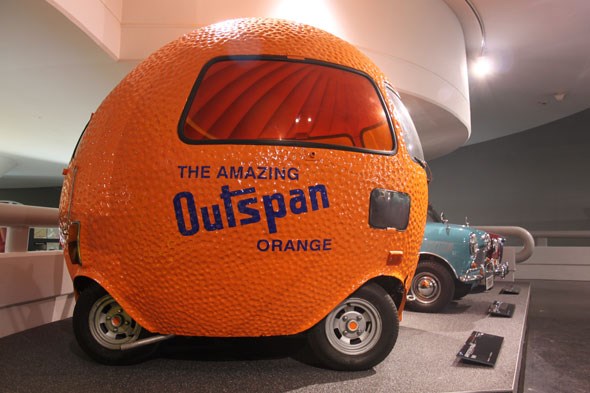
That would be the bizzare Outspan promo vehicle, six of which were built by a promotions company for a South African orange company looking to boost sales in Europe. They toured continental supermarkets in the early ’70s with the slogan ‘small ones are more juicy,’ we’re told. The fibreglass shell is reinforced with concrete and perched on drastically shortened Mini running gear. Best not make any jokes about body roll.

‘I say this about nearly all the cars here, but this one is my favourite,’ says Warming. The Moke was originally designed with military use in mind, as an off-road vehicle light enough to be dropped by parachute. It never quite cut it as an armed services off-roader though – maybe the 10-inch wheels had something to do with that – and it’s now remembered as a cult car of the peace-and-love era.
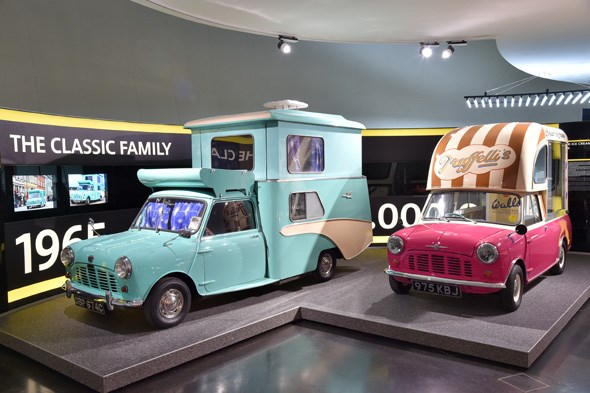
On the left, the amazing Mini Wildgoose camper from 1965. ‘We didn’t believe it still existed so we’re very happy to have it here,’ says Warming. The electrically powered roof can slide downwards to make it more aerodynamic, and incredibly its bulk is supported by 10-inch wheels and powered by a 34bhp 850cc engine. In its day it cost £998, or twice the price of a Mini van. On the right, the famous Mini ice cream truck built on a Clubman van base. Again, ‘lovely graphics, lovely colours’ says Anders.
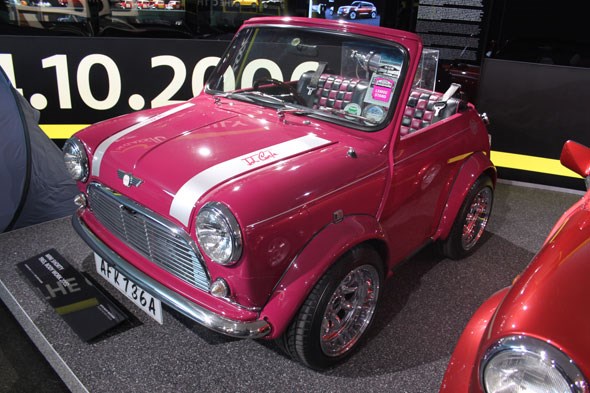
Parking a regular Mini too tricky? Try the Mini Shorty, a 1963 Mini that became a shocking pink (or just plain shocking) cut-and-shut in 2002, complete with nitrous injection.
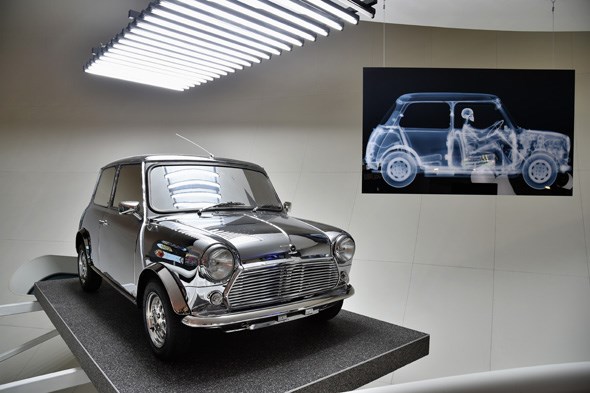
None other than rock legend David Bowie was commissioned to create this chromed art car in 1999. The X-ray pic in the background is by British photographer Nick Veasey.
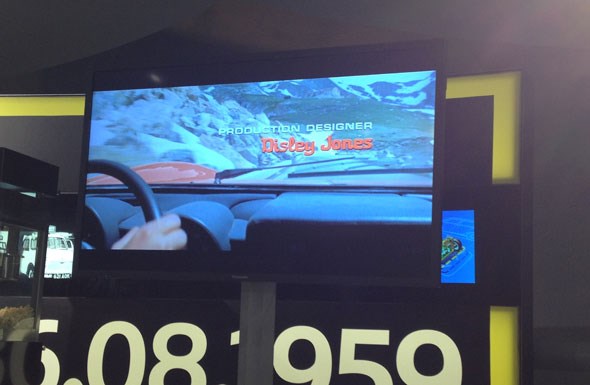
The Italian Job plays on a constant loop here. We had to stop and watch the Miura bit.
Shifting eras: modern Minis too
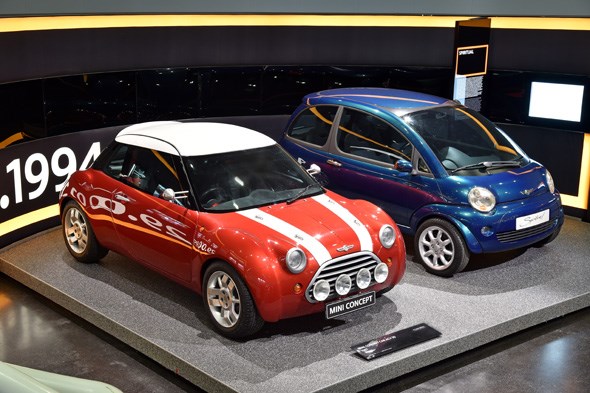
In 1997, two concepts were created to decide which direction the new Mini should take. One concentrated on the Mini’s prized driving dynamics and motorsport heritage, the other on its clever use of space. No prizes for guessing which one’s which – on the left is the ACV 30 study, a driveable concept on mid-engined MGF running gear penned by Adrian van Hooydonk (now running the design ship at BMW). On the right is the space-efficient Mini Spiritual concept, rear-engined for maximum interior room and with a clear reference to the original’s look. Warming says the latter was more influential on new Mini than the former, although given the 2001 car’s big on the outside, small on the inside dimensions, just how much is questionable.
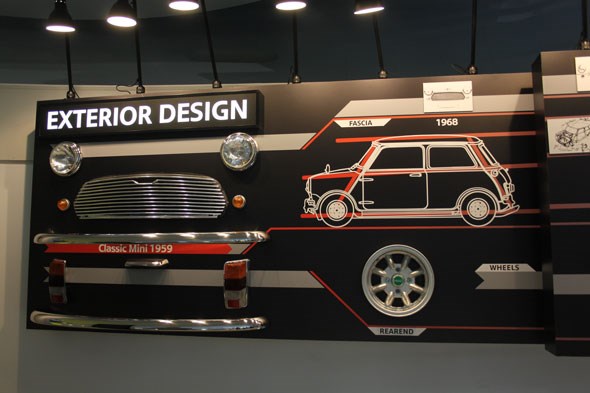
And these are the design themes that had to remain from the original, Warming explains: round headlights, a rough approximation of the hexagonal grille and upright tail-lights. ‘The headlights and look of the face of a Mini are so important’, he says, as is the wheel design: ‘The Mini is all about how it drives so the wheel design needs to reflect that.’
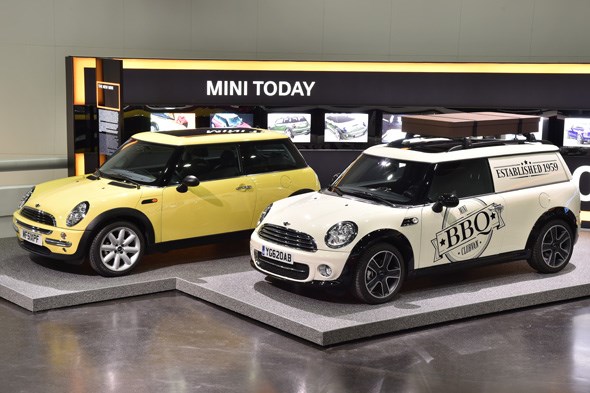
And here’s the result. The yellow car is the new Mini, the car from the 2001 display at the Frankfurt motor show.
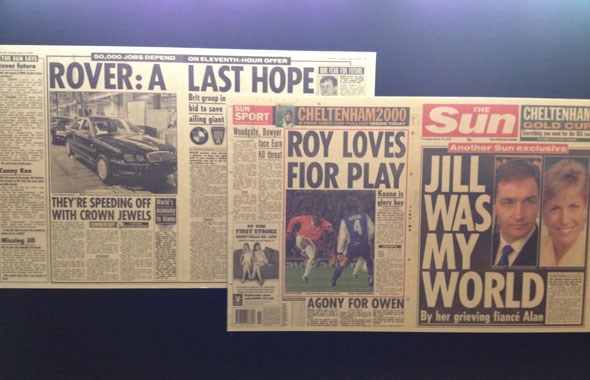
Incidentally, The Sun’s coverage of the beginning of the end for Rover is displayed a few feet from the 2001 Mini. Bad taste?
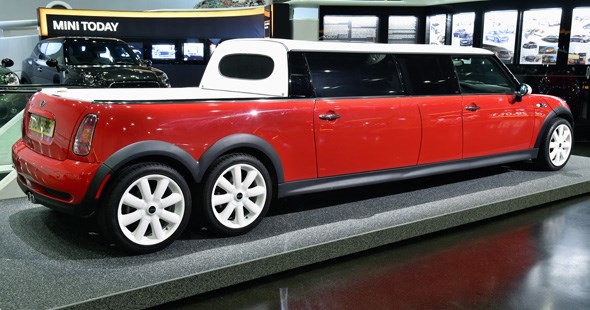
Mini’s innovative marketing has played a huge part in the brand’s success. The Mini ‘XXL’ was a guerrilla marketing stunt created for the 2004 Athens Olympics, explains Jochen Goller. It was created by an LA-based coachbuilder (the same guy who used to do Hummer conversions for Arnie, in fact). ‘We gave him two cars and a lot of spare pieces’, says Goller, and the result was this leviathan, complete with a swimming pool at the rear. It cruised the streets of Athens and generated ‘huge’ media coverage. ‘You probably couldn’t do it now’, says Goller, perhaps a little wistfully.
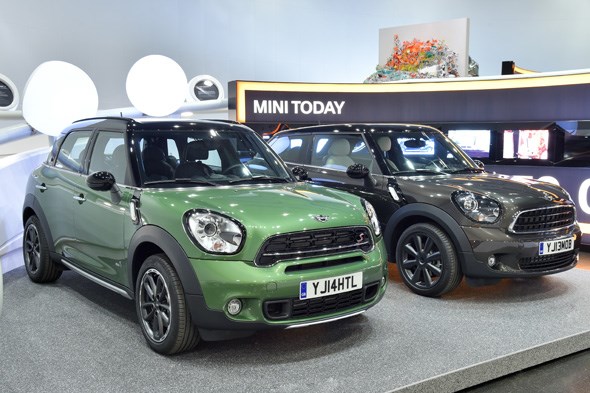
Not the most universally popular chapter in the Mini story. Anders Warming is a fan, though: ‘The Countryman was a genius design from Gert [Hildebrand, Warming’s predecessor as Mini’s design chief)’, says Anders. ‘And I believe the Paceman is a future classic. Such a unique car.’
The future
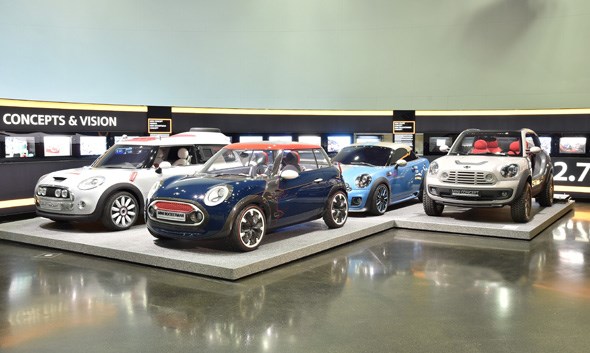
Also on display are some of Mini’s most influential concept cars. The 2010 Beachcomber (far right) riffed off the Moke, but was in fact the direct forerunner to the Countryman.
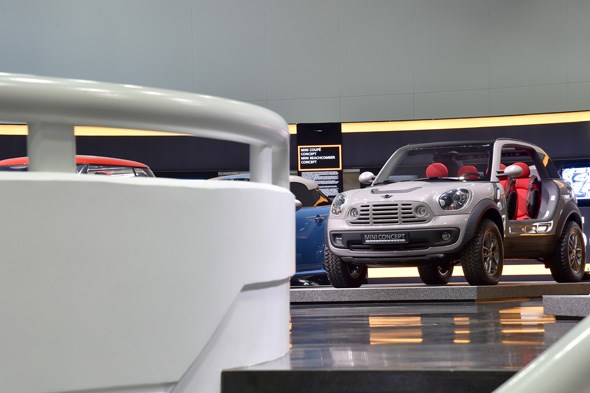
Remember that body-coloured grille on the original Mini-Minor earlier? That’s where the Beachcomber’s grille is pinched from.
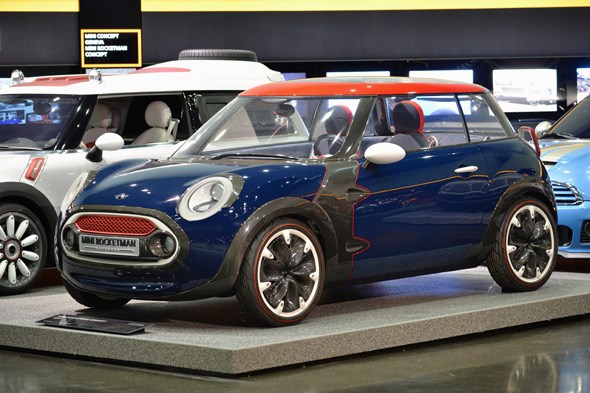
The 2011 Rocketman is perhaps Mini’s most intriguing concept yet. Genuinely miniature in size (it’s not all that much longer than the original, composed from carbonfibre, and not a scrap of chrome to be seen. Originally grey, it was repainted in ‘more British’ colours for the 2012 London Olympics, including red pinstriping: ‘I’m a big fan of pinstriping. I think it’s a lost art. So we aimed to bring it back as part of the London 2012 livery,’ says Warming.
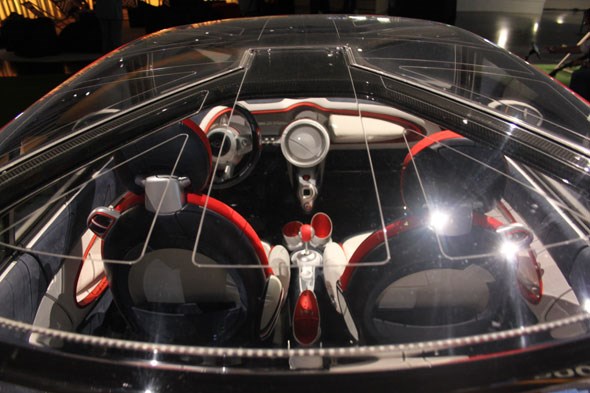
Years on, the Rocketman’s roof is still a striking design.
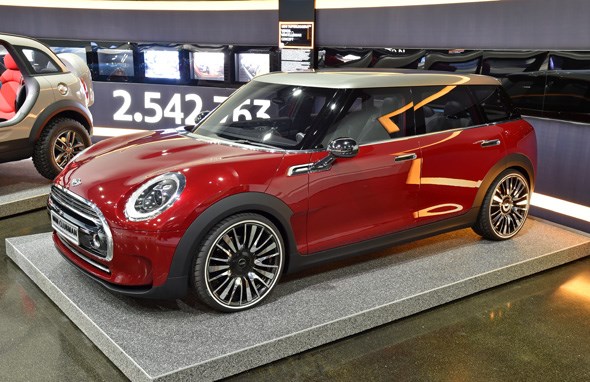
This is the latest Mini concept – the new Clubman, the production version of which is scheduled to surface at the Detroit show in early 2015. Mini concepts should always be production-viable, Warming believes. ‘We would never show something that could never happen,’ he says, and also intimates that extends to the Clubman concept’s paintwork and horizontal tail-lights – the first time a Mini’s rear lamps have been turned through 90 degrees.
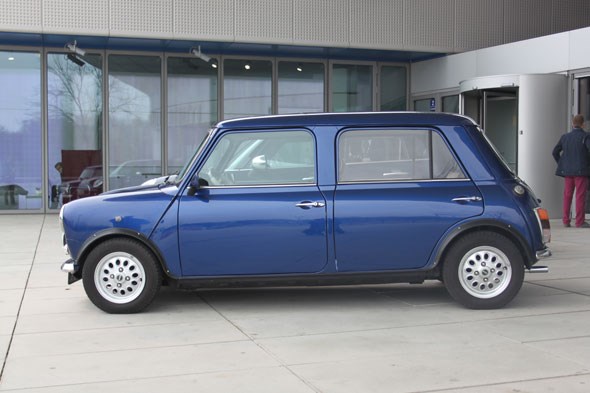
Final surprise at the museum is outside. This isn’t an illusion – it’s a four-door old-shape Mini, recreated especially for the exhibition. Turns out the idea of a Mini with more than two doors isn’t entirely new – this replica is based on a 1962 prototype, originally built around a Mini van. No originals exist and ’60s vans are now too precious to sacrifice, so the recreation is a cut ‘n’ shut built around a regular Mini. Insiders told us one of the main issues with creating a four-door Mini is avoiding it becoming unsustainably heavy, so the car’s on a high-fibreglass diet. Not sure how safe it would be in a rear end impact…
The Mini Story exhibition runs at the BMW museum in Munich until 31 January 2016. Click here to read Chris Chilton’s first drive of the new third-generation Mini.